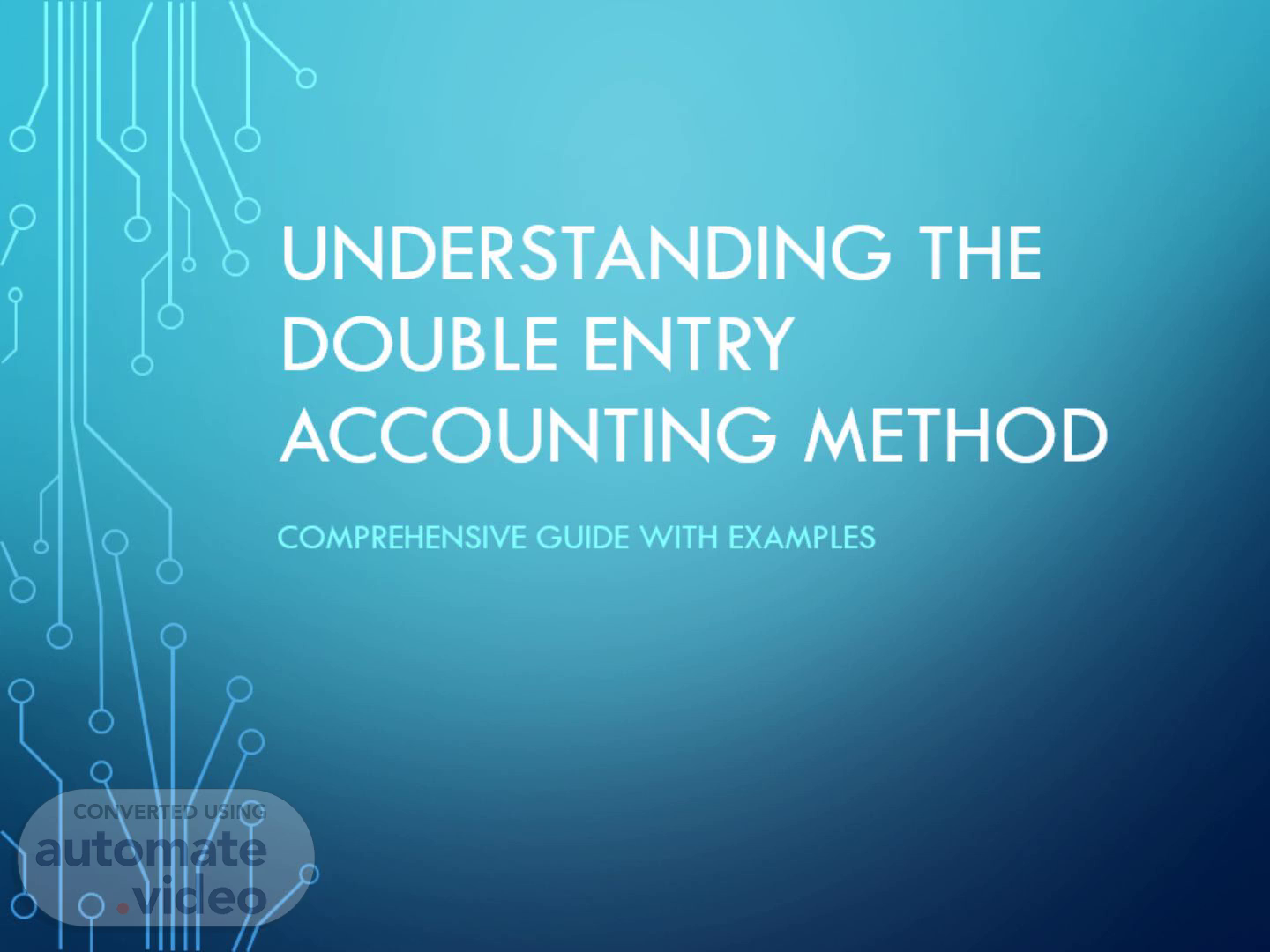
Understanding the Double Entry Accounting Method
Scene 1 (0s)
[Audio] Understanding the Double Entry Accounting Method Comprehensive Guide with Examples.
Scene 2 (7s)
[Audio] Introduction to Double Entry Accounting The double entry accounting method is fundamental in accounting to ensure the accounting equation (Assets = Liabilities + Stockholder’s Equity) remains balanced. It requires every transaction to affect at least two accounts, one debited and another credited. Explain the importance of the double entry method and its role in preventing errors while maintaining the integrity of financial records..
Scene 3 (37s)
[Audio] Key Concepts 1. Debits increase asset or expense accounts and decrease liability, stockholder’s equity, or revenue accounts. 2. Credits increase liability, stockholder’s equity, or revenue accounts and decrease asset or expense accounts. 3. The accounting equation (Assets = Liabilities + Stockholder’s Equity) must always balance. Discuss the significance of debits and credits and their application in balancing the accounting equation..
Scene 4 (1m 8s)
[Audio] Types of Accounts and Rules 1. Asset Accounts: Debit to increase; Credit to decrease. 2. Liability Accounts: Debit to decrease; Credit to increase. 3. Stockholder’s Equity Accounts: Debit to decrease; Credit to increase. 4. Revenue Accounts: Debit to decrease; Credit to increase. 5. Expense Accounts: Debit to increase; Credit to decrease. Provide examples for each account type and explain their respective rules..
Scene 5 (1m 44s)
[Audio] Example: Cash Sale of Goods Debit Cash: $500, Credit Sales Revenue: $500 Debit Cost of Goods Sold $200, Credit Inventory $200 Describe the transaction 'Cash Sale of Goods' in detail, focusing on the accounts involved and the rationale behind the debits and credits..
Scene 6 (2m 9s)
[Audio] Example: Purchase of Inventory on Credit Debit Inventory: $1,200, Credit Accounts Payable: $1,200 Describe the transaction 'Purchase of Inventory on Credit' in detail, focusing on the accounts involved and the rationale behind the debits and credits..
Scene 7 (2m 30s)
[Audio] Example: Payment of Rent Debit Rent Expense: $1,000, Credit Cash: $1,000 Describe the transaction 'Payment of Rent' in detail, focusing on the accounts involved and the rationale behind the debits and credits..
Scene 8 (2m 48s)
[Audio] Example: Receiving Cash from Accounts Receivable Debit Cash: $300, Credit Accounts Receivable: $300 Describe the transaction 'Receiving Cash from Accounts Receivable' in detail, focusing on the accounts involved and the rationale behind the debits and credits..
Scene 9 (3m 9s)
[Audio] Example: Paying a Prior Purchase On Account Debit Accounts Payable: $800, Credit Cash: $800 Describe the transaction 'Paying a Supplier' in detail, focusing on the accounts involved and the rationale behind the debits and credits..
Scene 10 (3m 27s)
[Audio] Example: Investment in corporation by its owners Debit Cash: $5,000, Credit Common Stock: $5,000 Describe the transaction 'Owner Investment' in detail, focusing on the accounts involved and the rationale behind the debits and credits..
Scene 11 (3m 46s)
[Audio] Example: Paying Employee Salaries Debit Salary Expense: $2,000, Credit Cash: $2,000 Describe the transaction 'Paying Employee Salaries' in detail, focusing on the accounts involved and the rationale behind the debits and credits..
Scene 12 (4m 5s)
[Audio] Example: recording Depreciation Expense Debit Depreciation Expense: $400, Credit Accumulated Depreciation: $400 Describe the transaction 'Depreciation Expense' in detail, focusing on the accounts involved and the rationale behind the debits and credits..
Scene 13 (4m 30s)
[Audio] Example: Sale of Equipment Debit Cash: $1,500, Debit Accumulated Depreciation: $1,500, Credit Equipment: $3,000 Describe the transaction 'Sale of Equipment' in detail, focusing on the accounts involved and the rationale behind the debits and credits..
Scene 14 (4m 53s)
[Audio] Example: Loan Received Debit Cash: $10,000, Credit Notes Payable: $10,000 Describe the transaction 'Loan Received' in detail, focusing on the accounts involved and the rationale behind the debits and credits..